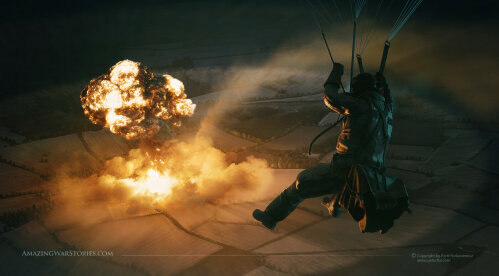Operation Husky – 80 Years On
Operation Husky, launched on July 10, 1943, marked a pivotal moment in World War II. It was the largest amphibious invasion in history up to that point, as Allied forces began their campaign to liberate the island of Sicily from Axis control. This operation not only set the stage for future successful landings in Italy but also showcased the courage and determination of the men involved.
Bruce is going out to Primosole Bridge this July, and we will be sharing some exclusive footage with our newsletter subscribers so make sure you sign up.

One of the critical objectives during Operation Husky was the capture of Primosole Bridge. Located on the eastern coast of Sicily, the bridge held strategic importance as it connected the British Eighth Army’s landing zones with their inland objectives. Its capture would facilitate the rapid advancement of Allied troops and ensure the success of the overall operation.
The defense of Primosole Bridge was entrusted to the 1st Battalion, the Parachute Regiment, under the command of Brigadier Gerald Lathbury. This highly skilled and dedicated officer had already gained a reputation for his bravery and leadership at Dunkirk. Lathbury was determined to hold the bridge at all costs and deny the enemy any chance of destroying it.
On the night of July 13, 1943, the 1st Battalion parachuted onto the Sicilian soil near Primosole Bridge – but the drop was a disaster, most of the force being scattered around the country – nowhere near the dropzones. However, as small group of paratroopers did make it to their objective and despite being outnumbered and facing fierce resistance from German troops, Lathbury and his men displayed remarkable courage and resilience. They fought tirelessly to repel numerous counterattacks, utilizing the advantage of their airborne training and superior knowledge of the bridge’s layout.
The battle for Primosole Bridge was a gruelling affair, with both sides sustaining heavy casualties – including Lathbury himself who was wounded in both thighs and his back. The Germans launched multiple assaults, employing tanks and skilled Paratroopers to dislodge the determined defenders. However, Lathbury’s leadership and the unwavering resolve of his men prevailed. They held their ground, inflicting significant losses on the enemy and preventing their attempts to retake the bridge.
The bravery and determination of Brigadier Lathbury and his men paid off. On July 14, 1943, after three days of intense fighting, the defenders of Primosole Bridge were relieved by advancing British forces. Their successful defence played a crucial role in ensuring the swift progress of the Allied advance towards their ultimate objective—liberating Sicily.
For his part Lathbury received a DSO (Distinguished Service Order) – his citation reads: This officer organised and led the attack by the 1st Parachute Brigade on a vital river crossing South of Catania in Sicily on the night 13th/14th July 1943. Although dropped by parachute 1.5 miles away, from a height of only 100 feet Brigadier Lathbury reached the objective, took part in its capture and directed the consolidation, during which he was wounded. Later, during a heavy counterattack by German parachutists, he remained at the bridge where he fought alongside his troops and provided an example and inspiration which contributed in no small degree to the success of the operation.

Operation Husky, including the capture of Primosole Bridge, was a key moment in the war. Although, at the time the landings were considered to be a bit of a disaster (only 12 of the 147 British gliders landed on target due to high winds – 69 crashed into the sea resulting in over 200 men drowning.) the Allies learnt some crucial lessons. It very clearly demonstrated the strengths and weaknesses of large-scale amphibious operations (which helped with the planning of D-Day in Normandy), it led to the downfall of Mussolini less than 4 months later and it also caused Hitler to divert forces away from the Eastern front to try and shore up his flank. The (albeit slow) success of this operation paved the way for subsequent campaigns in Italy and set the stage for the eventual liberation of Europe from Nazi control.
To learn more about Husky and Primosole Bridge please head over to the Airborne Assault Museum at Duxford where they have some truly unique artefacts.
Airborne Assault MuseumReturn to the post Archive





